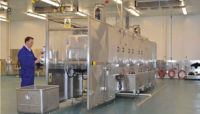Food-processing equipment poses unique challenges for maintenance personnel. Wet operating conditions and wash-down requirements can require specially designed equipment to help ensure mandated sanitation compliance. This results in increasing pressure for manufacturers to design food-processing equipment that is easier to clean and maintain and reduces downtime.
Millions of dollars are invested each year in capital improvements to facilities and equipment to increase product safety, protect employees and reduce costs. Equipment in a typical food-processing plant may run 16 to 20 hours a day seven days a week. Often, equipment failure is the most common cause for downtime. The longer it takes plant personnel to respond and repair equipment, the more damaging the interruption. What’s more, systems that are not at full speed create a domino effect that can result in missed deadlines, lost revenues and disappointed customers. According to one study cited on the Wipfli blog, unplanned downtime can cost a food processing facility an astounding $30,000 to $50,000 per hour.

Table of Contents:
Maintaining sanitation, reducing downtime
Food-processing plants are a very difficult environment for motors because equipment must be cleaned and sanitized daily. Harsh chemicals such as sodium hydroxide and other caustics are used to clean equipment and can be extremely corrosive. In addition to caustic chemicals, high-pressure spray is used, sometimes up to 1,000 pounds per square inch (PSI) with the nozzle held just a few inches away from the motor. While this ensures all contaminants are removed from the equipment, water enters these motors and does extensive damage.
Food-processing companies can help reduce foodborne illnesses and operating costs by using encapsulated stainless-steel food-safety motors. Unfortunately, because electric motors are often out of sight and out of mind until production is down because of a burnout, this improvement is often not thought about. Being proactive can have a dramatic effect on the bottom line.
A stainless-steel wash-down motor is suitable where motors are commonly exposed to moisture, humidity and some chemicals that cause corrosion. With the use of wash-down motors, flexibility and durability are enhanced, which can yield to minimal operating expenses while increasing up time. Hygienic equipment design not only mitigates the potential areas prone to harbor bacteria, but also facilitates post-sanitation evaluation by ensuring accessibility during visual verification and environmental monitoring.
Specially engineered stainless-steel motors also don’t have a need for paint that could flake into the food, hold in moisture and hide corrosion. They have a “totally enclosed, not ventilated” (TENV) design. This means they do not have a fan and fan cover, which are both difficult to clean and could be the breeding space for bacteria. For example, replacing all painted, standard motors on a plant’s conveyor belts — particularly in the processing area — with 2-horsepower stainless encapsulated motors allows for far greater reliability, particularly in these extreme conditions.
Through the installation of energy-efficient wash-down motors, food-processing plants can move from reactive to a more controlled, predictive maintenance approach and help improve sanitation, extend machine life and reduce operating costs. NP



Report Abusive Comment